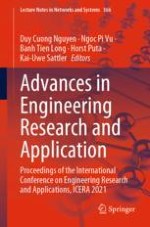This book covers the International Conference on Engineering Research and Applications (ICERA 2021), which took place at Thai Nguyen University of Technology, Thai Nguyen, Vietnam on December 1–2, 2021, and provided an international forum to disseminate information on latest theories and practices in engineering research and applications. The conference focused on original research work in areas including mechanical engineering, materials and mechanics of materials, mechatronics and micromechatronics, automotive engineering, electrical and electronics engineering, information and communication technology. By disseminating the latest advances in the field, the Proceedings of ICERA 2021, Advances in Engineering Research and Application, helps academics and professionals alike to reshape their thinking on sustainable development.
